Adaptive Handover Decision Using Fuzzy Logic for 5G Ultra-Dense Networks
Abstract
1. Introduction
2. Related Works
3. Proposed FLDHDT
3.1. System Architecture
3.2. Adaptive Handover Decision Using Fuzzy Logic
3.2.1. Data Pre-Processing
3.2.2. Inference Using Fuzzy Logic
- Fuzzifier
- B.
- Inference Engine and Rule Base
- C.
- Defuzzifier
3.2.3. Handover Decision
4. Performance Evaluation
4.1. Simulation Settings
4.2. Results and Discussions
5. Conclusions
Author Contributions
Funding
Data Availability Statement
Acknowledgments
Conflicts of Interest
References
- Network Experience Evolution to 5G. Available online: https://www.gsma.com/futurenetworks/resources/network-experience-evolution-to-5g/ (accessed on 1 September 2022).
- Mobile Data Traffic Outlook. Available online: https://www.ericsson.com/en/reports-and-papers/mobility-report/dataforecasts/mobile-traffic-forecast (accessed on 1 September 2022).
- Lin, Z.; Niu, H.; An, K.; Wang, Y.; Zheng, G.; Chatzinotas, S.; Hu, Y. Refracting RIS-Aided Hybrid Satellite-Terrestrial Relay Networks: Joint Beamforming Design and Optimization. IEEE Trans. Aerosp. Electron. Syst. 2022, 58, 3717–3724. [Google Scholar] [CrossRef]
- Lin, Z.; An, K.; Niu, H.; Hu, Y.; Chatzinotas, S.; Zheng, G.; Wang, J. SLNR-based Secure Energy Efficient Beamforming in Multibeam Satellite Systems. IEEE Trans. Aerosp. Electron. Syst. 2022. [Google Scholar] [CrossRef]
- Lin, Z.; Lin, M.; Wang, J.B.; De Cola, T.; Wang, J. Joint Beamforming and Power Allocation for Satellite-Terrestrial Integrated Networks with Non-Orthogonal Multiple Access. IEEE J. Sel. Top. Signal Process. 2019, 13, 657–670. [Google Scholar] [CrossRef]
- Park, J.; Kim, S.-L.; Zander, J. Asymptotic Behavior of Ultra-Dense Cellular Networks and Its Economic Impact. In Proceedings of the 2014 IEEE Global Communications Conference, Austin, TX, USA, 8–12 December 2014; pp. 4941–4946. [Google Scholar]
- Su, L.; Yang, C.; Chih-Lin, I. Energy and Spectral Efficient Frequency Reuse of Ultra Dense Networks. IEEE Trans. Wirel. Commun. 2016, 15, 5384–5398. [Google Scholar] [CrossRef]
- Baldemair, R.; Irnich, T.; Balachandran, K.; Dahlman, E.; Mildh, G.; Selén, Y.; Parkvall, S.; Meyer, M.; Osseiran, A. Ultra-Dense Networks in Millimeter-Wave Frequencies. IEEE Commun. Mag. 2015, 53, 202–208. [Google Scholar] [CrossRef]
- Liu, J.; Xiao, W.; Soong, A.C.; Anpalagan, A.; Bennis, M.; Vannithamby, R. Dense Networks of Small Cells. In Design and Deployment of Small Cell Networks; Cambridge University Press: Cambridge, UK, 2015; pp. 96–121. [Google Scholar]
- 5G; NR; Radio Resource Control (RRC); Protocol Specification (3GPP TS 38.331 Version 15.3.0 Release 15). Available online: https://www.etsi.org/deliver/etsi_ts/138300_138399/138331/15.03.00_60/ts_138331v150300p.pdf (accessed on 1 September 2022).
- Zadeh, L.A. Fuzzy Sets. Inf. Control 1965, 8, 338–353. [Google Scholar] [CrossRef]
- Bansod, N.A.; Kulkarni, M.; Patil, S.H. Soft Computing—A Fuzzy Logic Approach. In Soft Computing; Allied Publishers: New Delhi, India, 2005; pp. 73–75. [Google Scholar]
- Kaur, K.; Goyal, S.; Bhullar, A.K. Handover for 5G Networks using Fuzzy Logic: A Review. Int. J. Electr. Electron. Comput. 2021, 6, 25–33. [Google Scholar] [CrossRef]
- Duo, R.; Wu, C.; Yoshinaga, T.; Zhang, J.; Ji, Y. SDN-based Handover Scheme in Cellular/IEEE 802.11p Hybrid Vehicular Networks. Sensors 2020, 20, 1082. [Google Scholar] [CrossRef] [PubMed]
- Lee, J.; Yoo, Y. Handover cell Selection Using User Mobility Information in a 5G SDN-based Network. In Proceedings of the 2017 9th International Conference on Ubiquitous and Future Networks (ICUFN), Milan, Italy, 4–7 July 2017; pp. 697–702. [Google Scholar]
- Mollel, M.S.; Abubakar, A.I.; Ozturk, M.; Kaijage, S.F.; Kisangiri, M.; Hussain, S.; Imran, M.A.; Abbasi, Q.H. A Survey of Machine Learning Applications to Handover Management in 5G and Beyond. IEEE Access 2021, 9, 45770–45802. [Google Scholar] [CrossRef]
- Tanveer, J.; Haider, A.; Ali, R.; Kim, A. An Overview of Reinforcement Learning Algorithms for Handover Management in 5G Ultra-Dense Small Cell Networks. Appl. Sci. 2022, 12, 426. [Google Scholar] [CrossRef]
- Yajnanarayana, V.; Rydén, H.; Hévizi, L. 5G Handover Using Reinforcement Learning. In Proceedings of the 2020 IEEE 3rd 5G World Forum (5GWF), Bangalore, India, 10–12 September 2020; pp. 349–354. [Google Scholar]
- Zhao, S.; Jiang, X.; Jacobson, G.; Jana, R.; Hsu, W.L.; Rustamov, R.; Talasila, M.; Aftab, S.A.; Chen, Y.; Borcea, C. Cellular Network Traffic Prediction Incorporating Handover: A Graph Convolutional Approach. In Proceedings of the 2020 17th Annual IEEE International Conference on Sensing, Communication, and Networking (SECON), Como, Italy, 22–25 June 2020; pp. 1–9. [Google Scholar]
- Chen, Y.S.; Chang, Y.J.; Tsai, M.J.; Sheu, J.P. Fuzzy-Logic-Based Handover Algorithm for 5G Networks. In Proceedings of the 2021 IEEE Wireless Communications and Networking Conference (WCNC), Nanjing, China, 29 March–1 April 2021; pp. 1–7. [Google Scholar]
- Souza, D.D.S.; Vieira, R.F.; Seruffo, M.-H.C.D.R.; Cardoso, D.L. A Novel Heuristic for Handover Priority in Mobile Heterogeneous Networks. IEEE Access 2019, 8, 4043–4050. [Google Scholar] [CrossRef]
- Goutam, S.; Unnikrishnan, S.; Singh, P.; Karandikar, A. Algorithm for Handover Decision Using Fuzzy Logic. In Proceedings of the 2020 IEEE Bombay Section Signature Conference (IBSSC), Mumbai, India, 4–6 December 2020; pp. 25–30. [Google Scholar]
- Huey, R.-S.; Lin, T.-M.; Hsu, C.-K. Predictive Handover Approach for Dynamic Resource Management in 5G Heterogeneous Networks using Grey Fuzzy Logical Control. In Proceedings of the 2022 8th International Conference on Applied System Innovation (ICASI), Nantou, Taiwan, 22–23 April 2022; pp. 187–192. [Google Scholar]
- Banna, R.E.; ELAttar, H.M.; Abou El-Dahab, M.M. Fast Adaptive Handover using Fuzzy Logic for 5G Communications on High Speed Trains. In Proceedings of the 2021 16th International Conference on Telecommunications (ConTEL), Zagreb, Croatia, 30 June–2 July 2021; pp. 10–17. [Google Scholar]
- Alraih, S.; Nordin, R.; Abu-Samah, A.; Shayea, I.; Abdullah, N.F.; Alhammadi, A. Robust Handover Optimization Technique with Fuzzy Logic Controller for Beyond 5G Mobile Networks. Sensors 2022, 22, 6199. [Google Scholar] [CrossRef]
- Mamdani, E.H.; Assilian, S. An Experiment in Linguistic Synthesis with a Fuzzy Logic Controller. Int. J. Man-Mach. Stud. 1975, 7, 1–13. [Google Scholar] [CrossRef]
- Hájek, P. Metamathematics of Fuzzy Logic; Kluwer Academic Publishers: Dordrecht, The Netherlands; Boston, MA, USA; London, UK, 1998. [Google Scholar]
- LTE Metrics Including RSRP, RSRQ and SINR. Available online: https://www.cablefree.net/wirelesstechnology/4glte/lte-rsrq-sinr/ (accessed on 1 September 2022).
- Abbas, A. Fuzzy Logic Control in Support of Autonomous Navigation of Humanitarian De-mining Robots. In Book Chapter of Using Robots in Hazardous Environments; Elsevier: Amsterdam, The Netherlands, 2011; pp. 453–475. [Google Scholar]
- ns-3 Simulator with mmWave Module. Available online: https://github.com/nyuwireless-unipd/ns3-mmwave (accessed on 1 September 2022).
- Chiang, K.-H.; Shenoy, N. A 2-D Random-Walk Mobility Model for Location-Management Studies in Wireless Networks. IEEE Trans. Veh. Technol. 2004, 53, 413–424. [Google Scholar] [CrossRef]
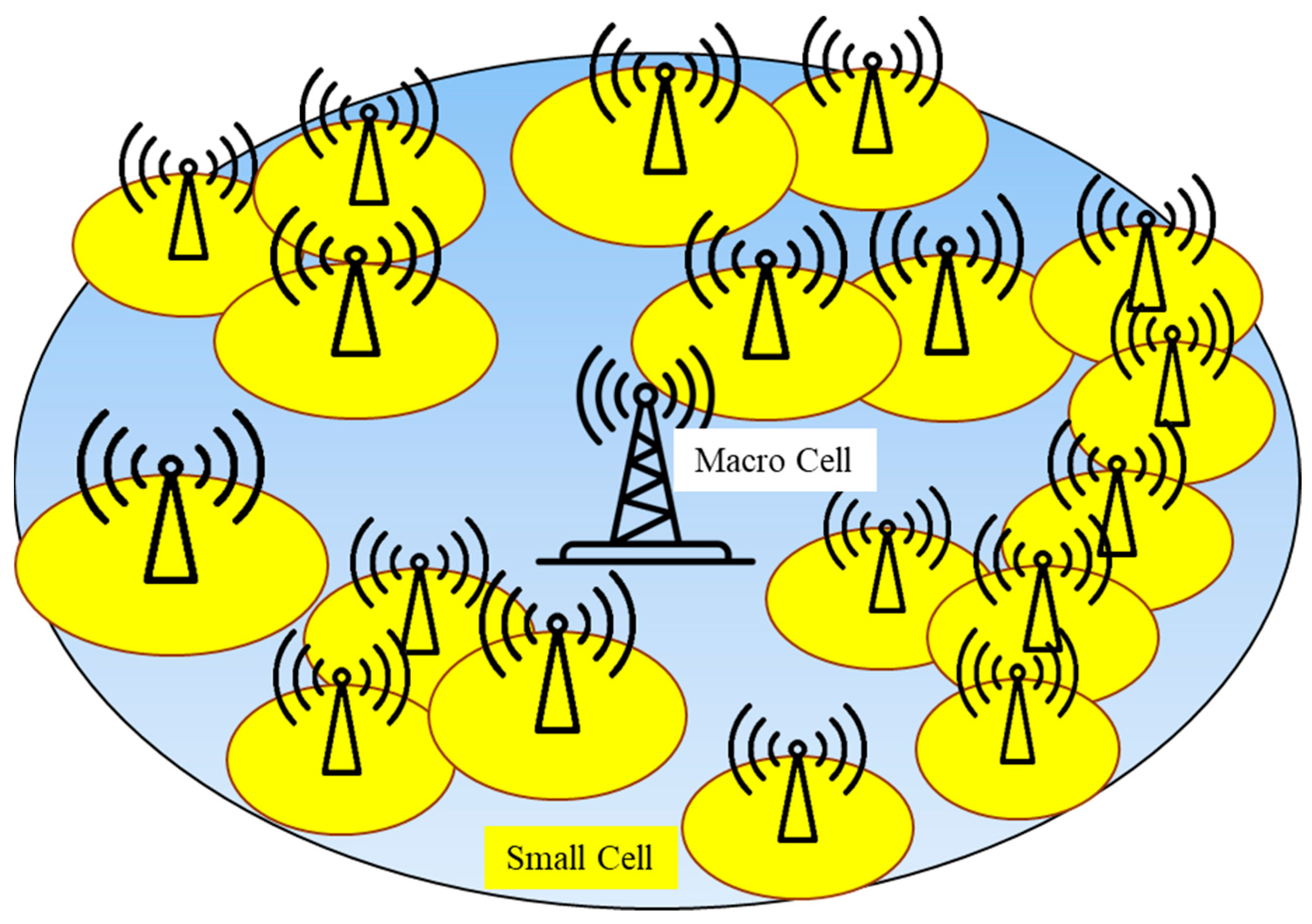
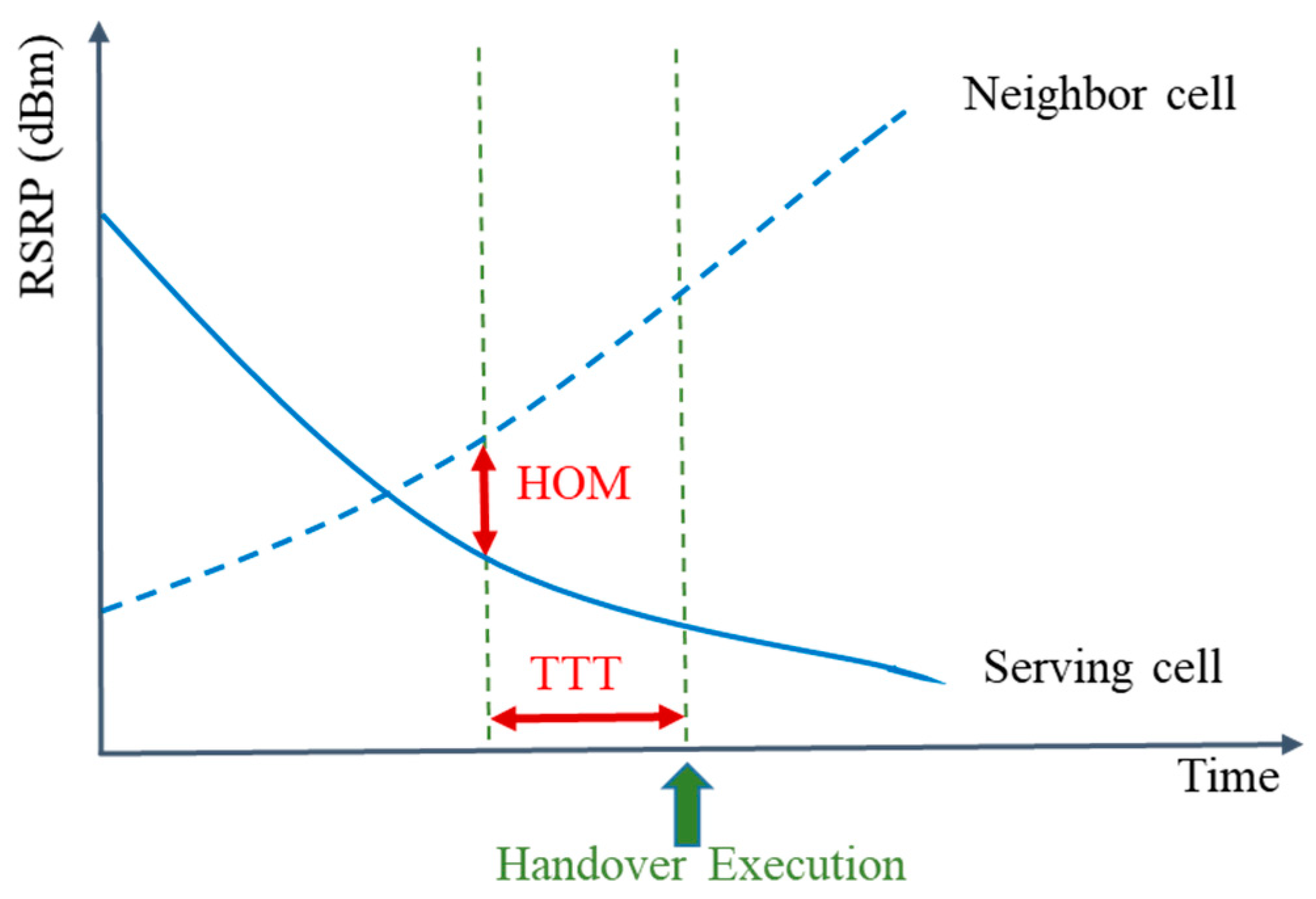
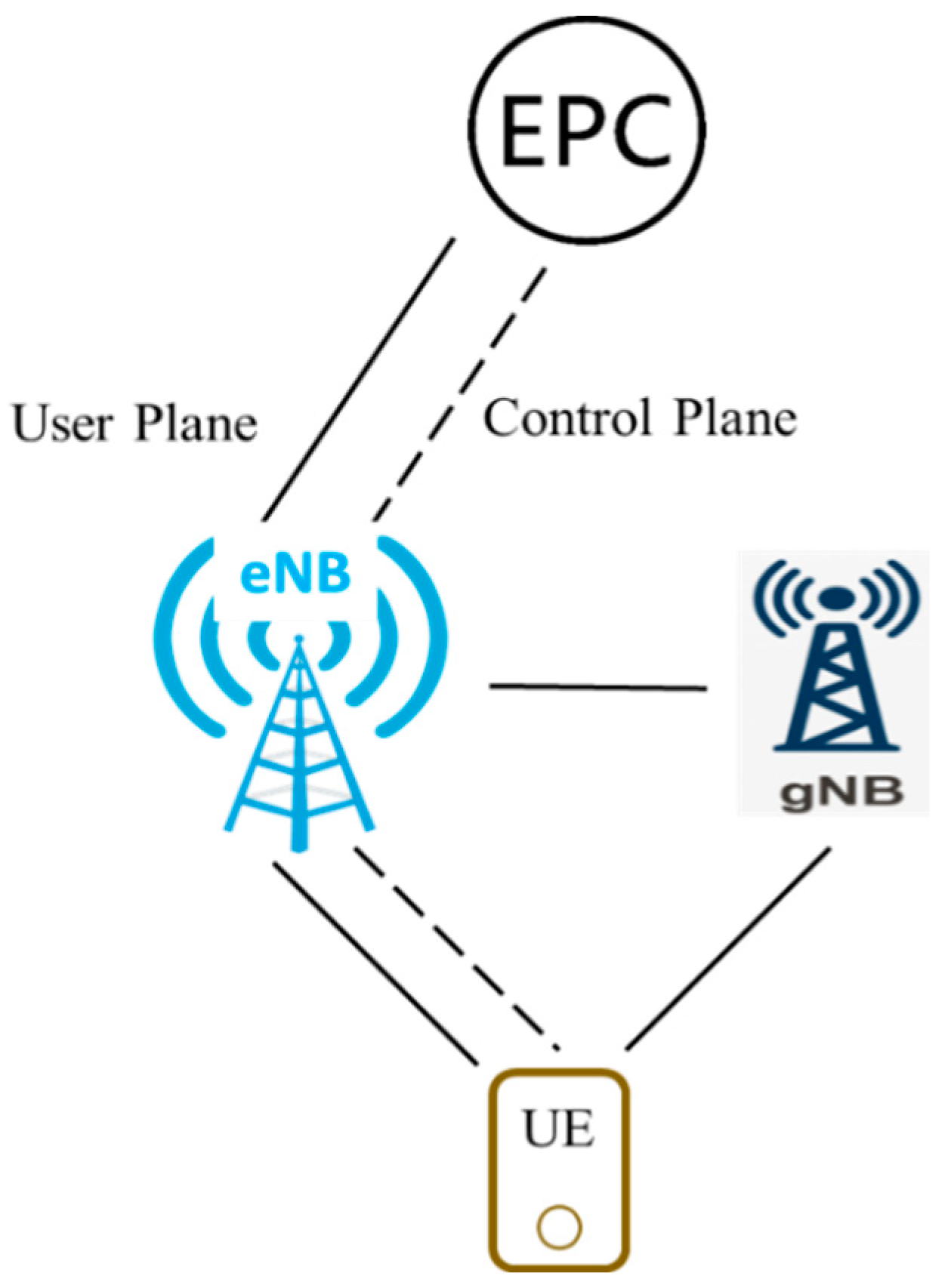
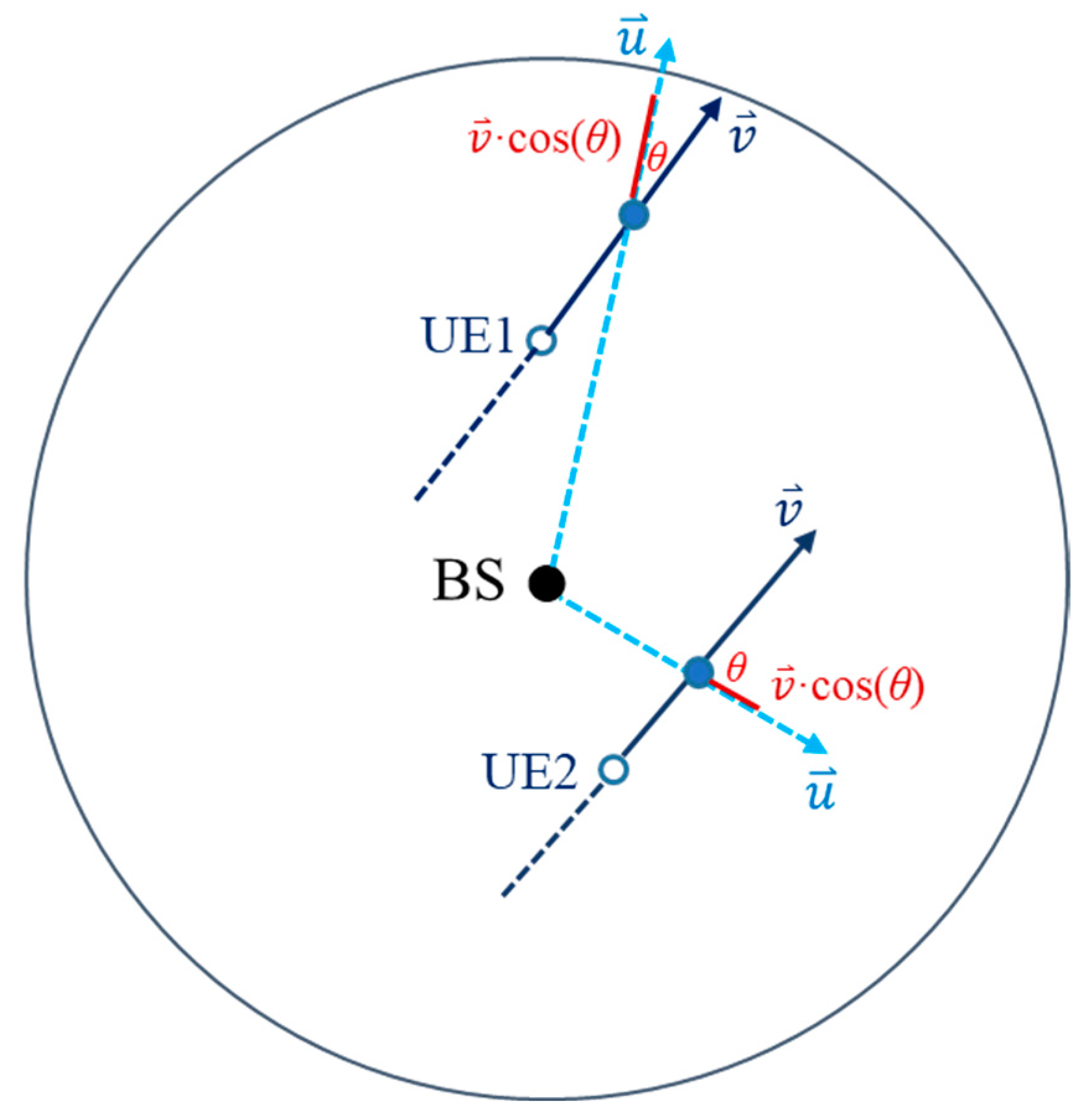
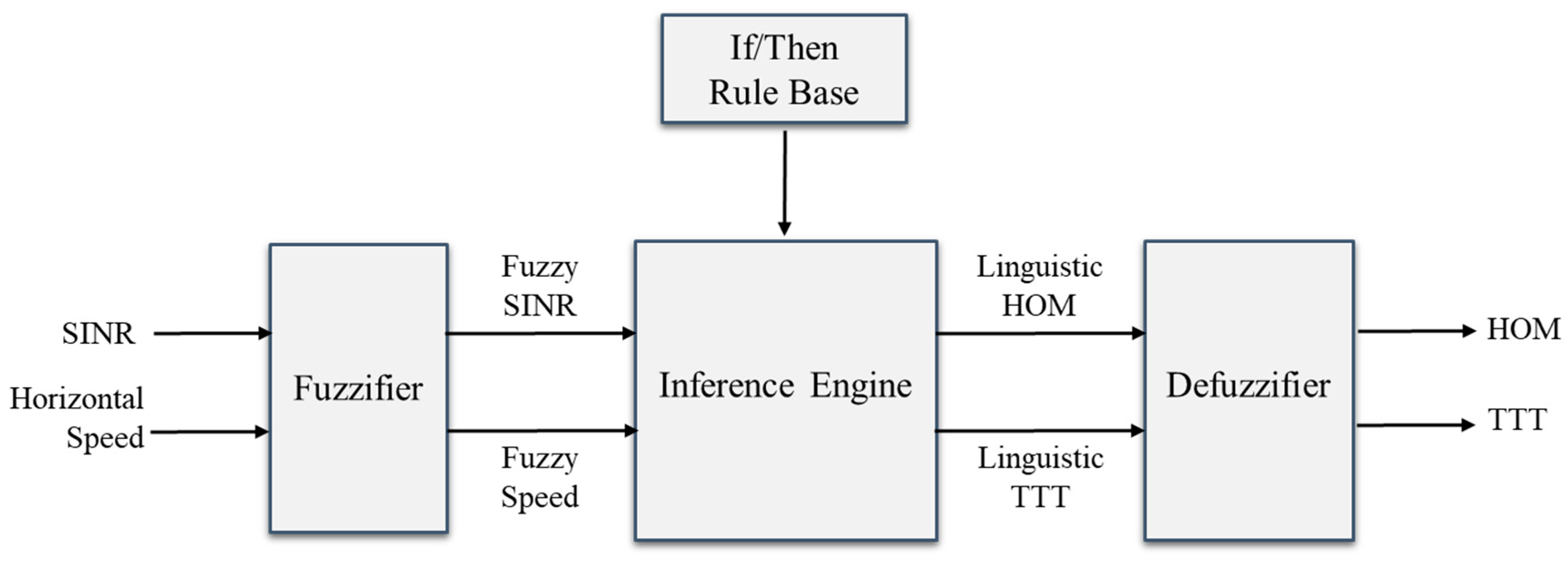
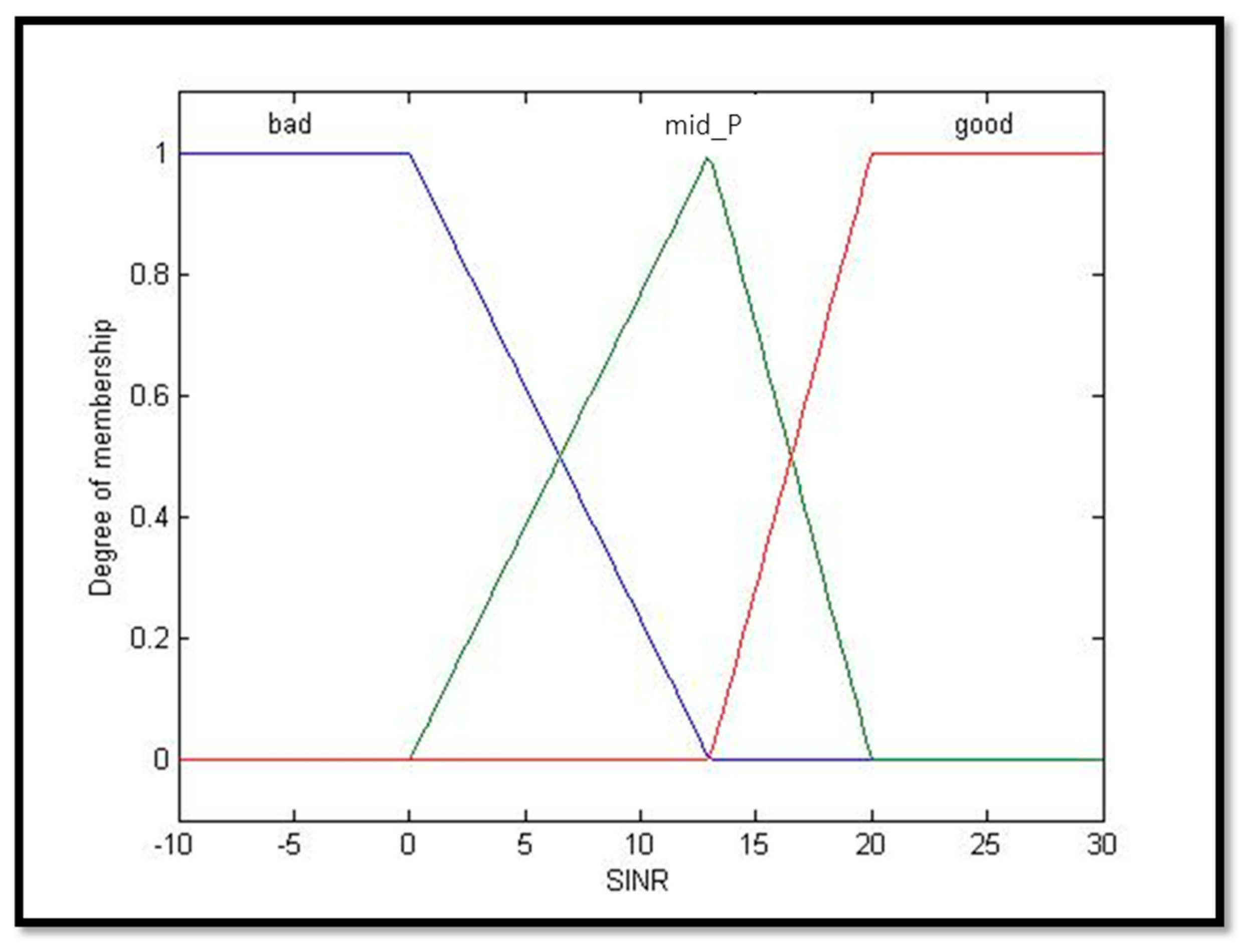

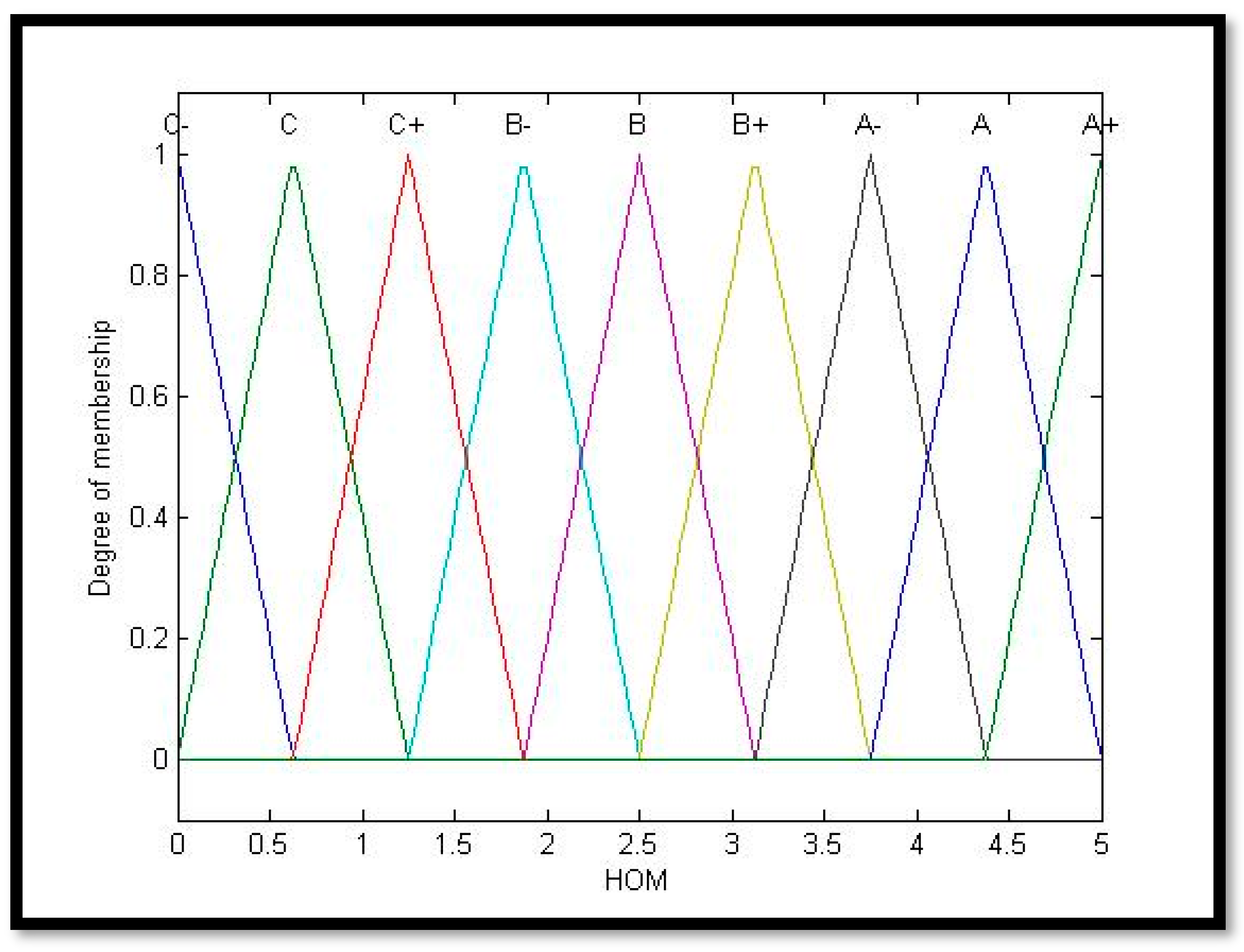

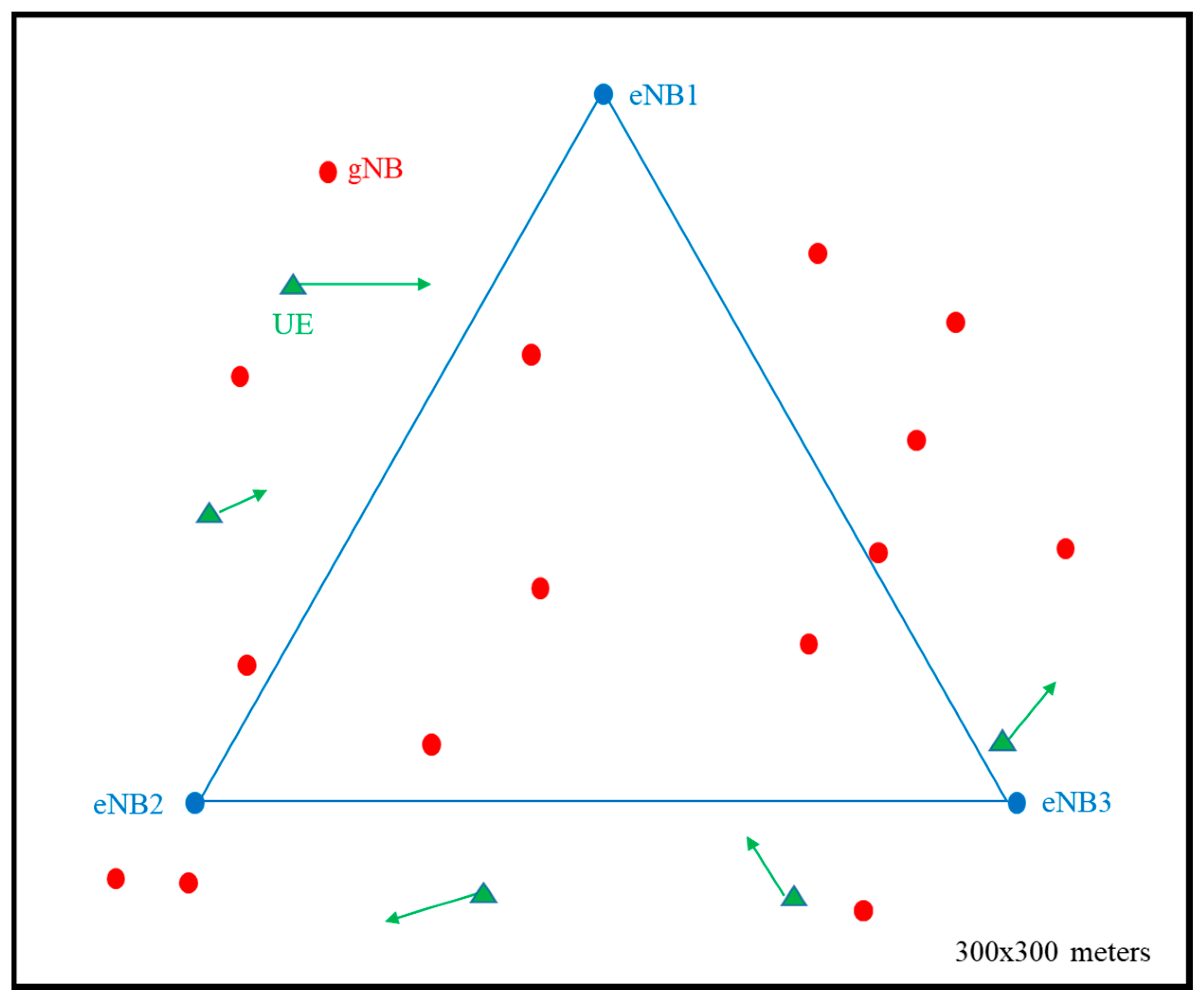
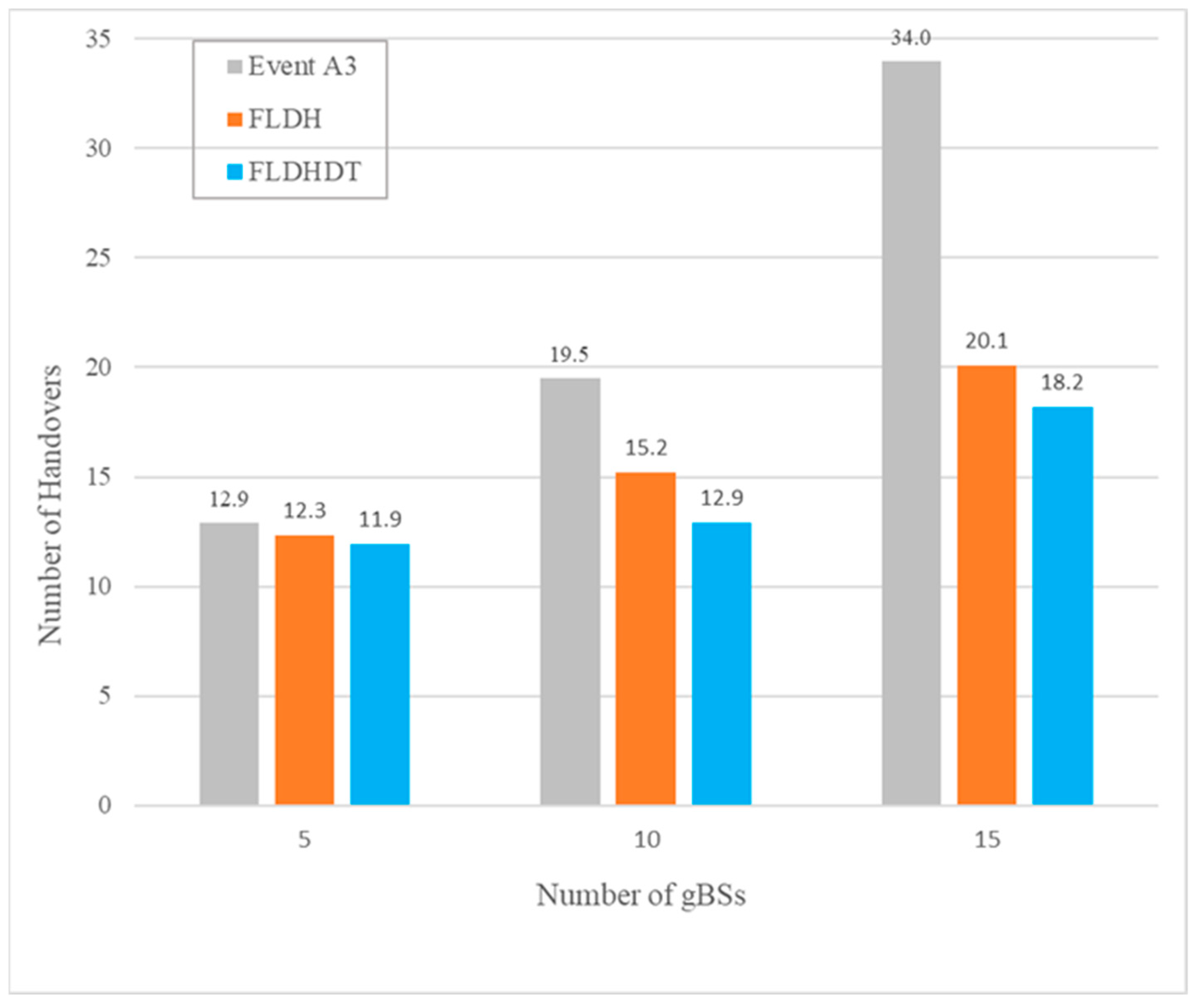
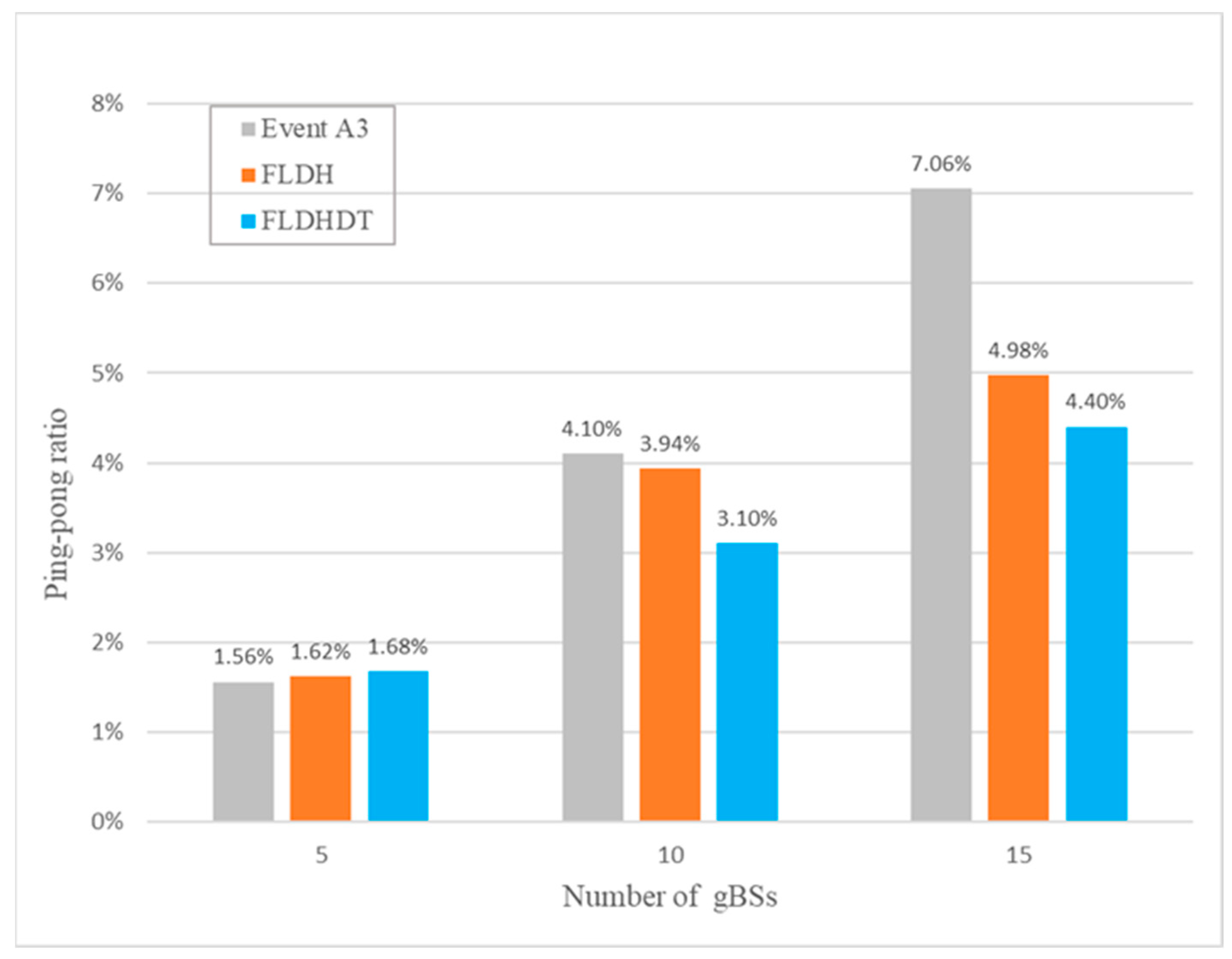
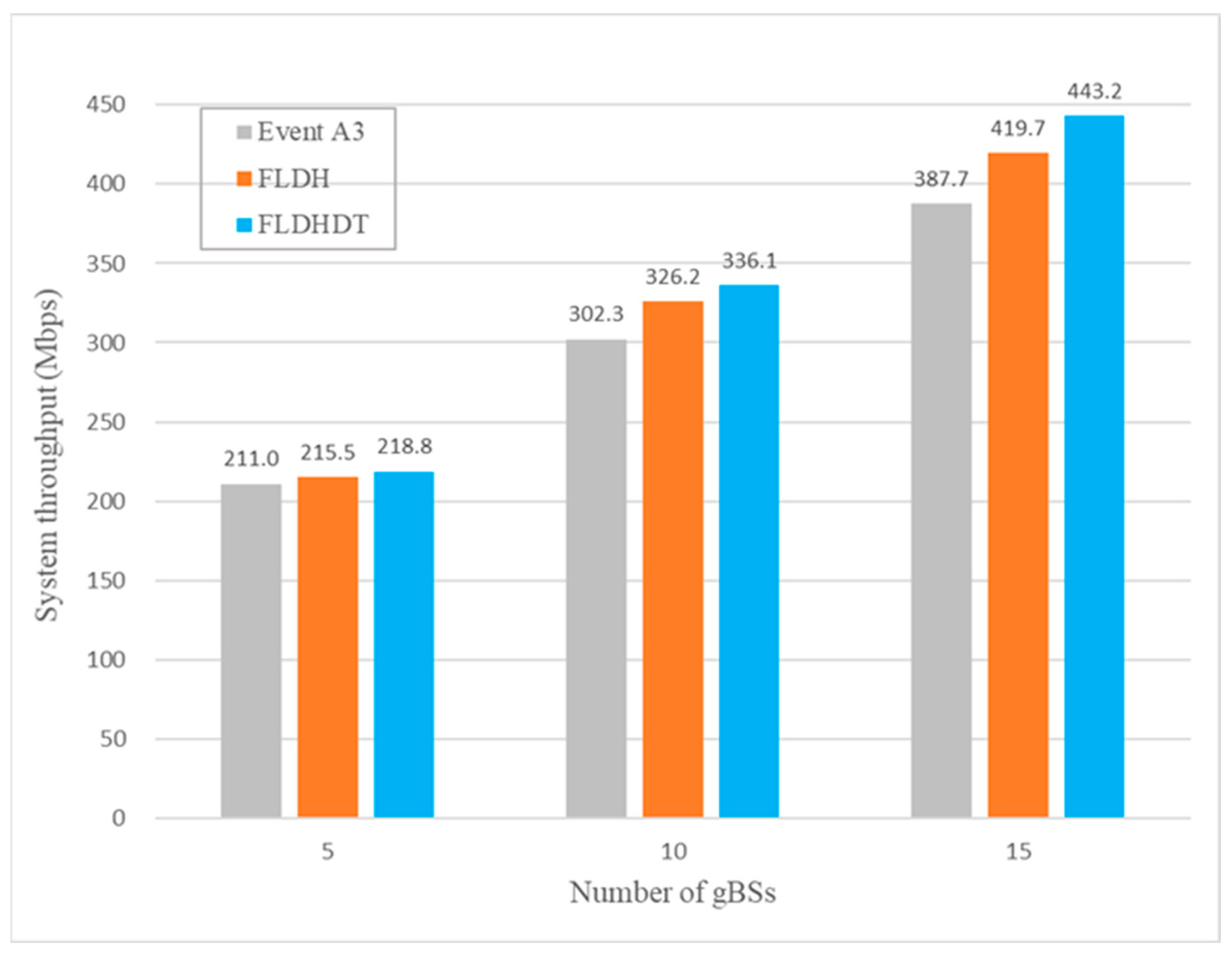
| Event | Trigger Scenario |
|---|---|
| A1 | Serving is better than the threshold |
| A2 | Serving is worse than the threshold |
| A3 | Neighbor is offset better than the serving cell |
| A4 | Neighbor is better than the threshold |
| A5 | Serving is worse than threshold_1, and neighbor is better than threshold_2 |
| A6 | Neighbor is offset better than the secondary serving cell |
| B1 | Inter-RAT neighbor is better than the threshold |
| B2 | Serving is worse than threshold_1, and inter-RAT neighbor is better than threshold_2 |
| Signal Strength | RSRP (dBm) | RSRQ (dB) | SINR (dB) |
|---|---|---|---|
| Excellent | ≧−80 | ≧−10 | ≧20 |
| Good | −80~−90 | −10~−15 | 13~20 |
| Mid Cell | −90~−100 | −15~−20 | 0~13 |
| Cell Edge | ≦−100 | ≦−20 | ≦0 |
| In | Out | ||
|---|---|---|---|
| SINR | Speed | HOM | TTT |
| bad | fast | C- | C- |
| bad | mid_V | C | B- |
| bad | slow | C+ | A- |
| mid_P | fast | B- | C |
| mid_P | mid_V | B | B |
| mid_P | slow | B+ | A |
| good | fast | A- | C+ |
| good | mid_V | A | B+ |
| good | slow | A+ | A+ |
|
| Parameters | Values |
|---|---|
| Simulator | NS3-3.30 |
| Simulation area | 300 × 300 m |
| Number of eNBs | 3 |
| Number of gNBs | 5, 10, 15 |
| Number of UEs | 5 |
| UE mobility model | 2-D random walk |
| UE speed | 2~20 m/s |
| Power of eNB/gNB | 43 dBm/23 dBm |
| Frequency of eNB/gNB | 2.4 GHz/28 GHz |
| Packet inter-arrival time | 20 microseconds |
| Packet size | 1000 bytes |
| Measurement report period | 200 milliseconds |
| eNB Bandwidth | 20 Mbps |
| gNB Bandwidth | 100 Mbps |
| Simulation time | 30 s |
| Scheme | Event A3 | FLDH | FLDHDT |
|---|---|---|---|
| Using fuzzy logic | No | Yes | Yes |
| HOM | fixed | dynamic | dynamic |
| TTT | fixed | fixed | dynamic |
Publisher’s Note: MDPI stays neutral with regard to jurisdictional claims in published maps and institutional affiliations. |
© 2022 by the authors. Licensee MDPI, Basel, Switzerland. This article is an open access article distributed under the terms and conditions of the Creative Commons Attribution (CC BY) license (https://creativecommons.org/licenses/by/4.0/).
Share and Cite
Hwang, W.-S.; Cheng, T.-Y.; Wu, Y.-J.; Cheng, M.-H. Adaptive Handover Decision Using Fuzzy Logic for 5G Ultra-Dense Networks. Electronics 2022, 11, 3278. https://doi.org/10.3390/electronics11203278
Hwang W-S, Cheng T-Y, Wu Y-J, Cheng M-H. Adaptive Handover Decision Using Fuzzy Logic for 5G Ultra-Dense Networks. Electronics. 2022; 11(20):3278. https://doi.org/10.3390/electronics11203278
Chicago/Turabian StyleHwang, Wen-Shyang, Teng-Yu Cheng, Yan-Jing Wu, and Ming-Hua Cheng. 2022. "Adaptive Handover Decision Using Fuzzy Logic for 5G Ultra-Dense Networks" Electronics 11, no. 20: 3278. https://doi.org/10.3390/electronics11203278
APA StyleHwang, W.-S., Cheng, T.-Y., Wu, Y.-J., & Cheng, M.-H. (2022). Adaptive Handover Decision Using Fuzzy Logic for 5G Ultra-Dense Networks. Electronics, 11(20), 3278. https://doi.org/10.3390/electronics11203278








